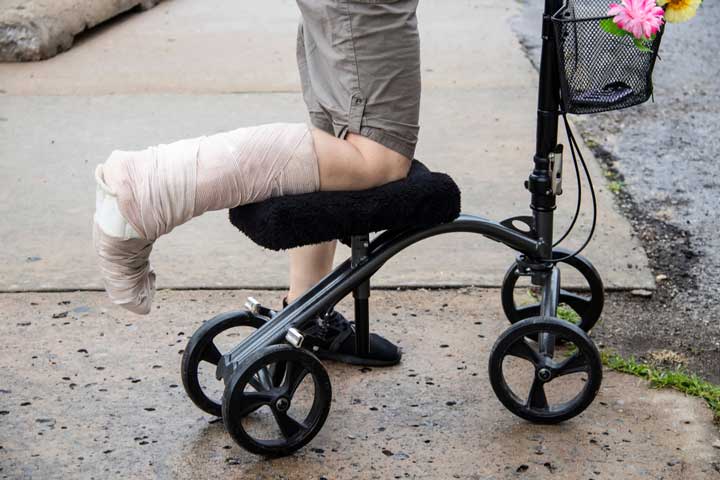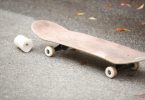iWalk and knee scooters are handy medical mobility devices and great replacement options for the old-fashioned crutches.
With these advancements, you have the opportunity to avoid traditional crutches to drag your body. Your wrist, hand, underarm, and shoulders will be safe from any possible injuries too.
Pros & Cons of iWalks and Knee Scooters

iWalk Pros
- iWalk is less spacious and lighter than the knee scooter, even at 5 lbs. It’s incomparably comfortable in a sitting position.
- It’s more economical than the knee scooter.
- iWalk offers a normal walking pattern to the other healthy leg.
- It lifts your leg; so, you don’t have to worry about tangling your leg in the crutches anymore, thus boosting the healing process.
- It frees your hands and arms, providing more independence to work with your hands.
- It is great for short distances, roaming around in the house, and climbing stairs.
iWalk Cons
- Its frequent use can rug-burn your knee skin, and form a scab. You can’t use it again unless you recover. Use additional padding.
- For long distances, it’s tiresome and can hurt your hip and back.
- It’s not recommended for a healthy person who weighs more than 275 lbs.
- Although it’s easy-going in the house, it still requires a lot of practice and skills to handle.
- Using the stairs is tricky and can make you lose balance. Try handrails.
Knee Scooter Pros
- A knee scooter is totally safe for your knee and will not rug-burn the skin because of the smooth cushioning
- It gives a long and smooth ride; hence it’s a great option for long distances.
- It requires less practice and is stable in itself. (Try padded shorts for protection)
- With it, your leg is uplifted and safe, resulting in a quick recovery.
- It’s great for a healthy person who has some serious weight: it can bear serious weight with a smooth ride.
Knee Scooter Cons
- Clearly, you can’t roam in the house on a knee scooter; it covers a lot of space, thus difficult to turn at sharp corners, or in narrow hallways.
- It’s not helpful at all when it comes to the stairs.
- It’s quite expensive when compared to an iWalk or free crutches. Therefore, it’s not an option for everyone.
- It’s heavy, restricting your arm movement.
- It’s not good on rocky, brick sidewalks because sudden jolts are not good for healing.
How are a Knee Scooter and an iWalk Similar?
- These two are used for all the lower leg injuries, in which your leg can’t bear the body’s weight.
- They’ll keep the injured lower leg elevated, and at rest, thus stimulating the healing process.
- They’re a great alternative to traditional crutches. While keeping the balance of traditional crutches, there’s a great risk of hurting your wrists, shoulders, hands, or underarms. Now, with the knee scooter and iWalk, you can eliminate these risks.
iWalk Vs Knee Scooter – In-Depth Comparison
| Questions | iWalk | Knee scooter |
| Can you replace this device successfully with traditional crutches? | Yes, it’s actually way better than the traditional crutches, and will eliminate additional aching that traditional causes. | Yes, you are free from pain (arms, shoulders, wrist, and underarms) cause by traditional crutches. |
| Is this device for lower leg injuries? | Yes, this is for lower leg injuries in which your leg can’t bear the body’s weight. | Yes, this is for lower leg injuries, when your leg doesn’t support you standing. |
| Does it heal the injury quicker than traditional crutches? | Yes, this device heals the injury quickly because of the leg’s elevated resting position. | Yes, knee scooter speeds up the healing process by offering an elevated resting position to the injured lower leg. |
| Does it offer independent hand movement, unlike traditional crutches? | Yes, it offers complete freedom to your hands, unlike traditional crutches. | No, you need both hands to steer the scooter. You can’t do normal stuff while riding. |
| Can you use it inside the house? | Yes, you can use iWalk inside the house, including stairs. | No, you can’t use a knee scooter inside the house. |
| Can you use this device on different surfaces? | Yes, it can offer to help you walk on all surfaces like grass, gravel, curbs, slopes, and others. | No, it can just offer smooth ride you on hard and flat surfaces. |
| Can it bear excessive weight? | No, it can only handle up to 275 lbs. | Yes, it can bear some excessive weight. |
| Can this cover long distances? | No, iWalk will cause back and hip pain. | Yes, it will offer you a long ride with ease. |
FAQs
1. Are knee scooters better than crutches?
Ans. Definitely. A knee scooter is by far better, because of its mobility and stability. Plus, you can cover long distances while keeping your leg at rest and don’t have to rely on the upper body to drag your leg.
2. Are knee scooters covered by insurance?
Ans. It depends on the company’s policy. Unfortunately, most insurance companies don’t cover knee scooters. Although, if they do, you need a prescription or a letter by a doctor along with the paid invoice.
3. Do knee scooters come with brakes?
Ans. Yes, knee scooters have brakes, because they are not just used indoors, but you can take them outside for a ride as well. It has two adjustable handbrakes and dual rear on-wheel brakes.









Leave a Comment